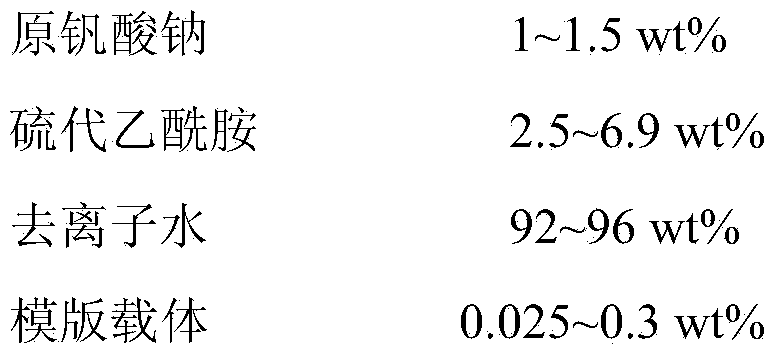Visible-light-induced photocatalyst loaded with vanadium tetrasulfide and preparation method
A technology of vanadium tetrasulfide and catalyst is applied in the field of photocatalysis to achieve the effect of improving quantum efficiency and promoting separation
- Summary
- Abstract
- Description
- Claims
- Application Information
AI Technical Summary
Problems solved by technology
Method used
Image
Examples
Embodiment 1
[0015] Example 1: Visible light catalytic degradation of waste water containing formaldehyde
[0016] Prepare the catalyst as follows:
[0017] 1) Weigh 0.1343g of carbon nanotubes (CNTs), disperse them in 90mL of deionized water, and sonicate for 0.5h to form a homogeneous solution, ready for use;
[0018] 2) Weigh 2.7g sodium orthovanadate dodecahydrate and 7.5g thioacetamide (CH 3 CSNH 2 ), dissolved in the solution obtained in 1), and continuously stirred for 0.5h; transferred to a 150mL high-temperature hydrothermal reaction kettle, kept at 150°C for 12h, and cooled naturally to room temperature.
[0019] 3) The obtained product was centrifuged, washed with water and ethanol for 3 to 5 times, dried in vacuum at 60° C. for 6 hours, and ground to obtain VS containing 5% carbon nanotubes. 4 catalyst.
[0020] Prepare 500mL simulated industrial wastewater containing 1% formaldehyde solution, add 0.5g of the above catalyst, simulate sunlight with a 500W high-pressure xenon...
Embodiment 2
[0023] Example 2: Visible light catalytic decomposition of water to produce hydrogen
[0024] Prepare the catalyst as follows:
[0025] 1) Weigh 0.0537g graphene oxide (GO), disperse it in 60mL deionized water, and ultrasonicate for 1h to form a homogeneous solution, ready for use;
[0026] 2) Weigh 1.8g Na 3 VO 4 12H 2 O and 1.65g CH 3 CSNH 2 , dissolved in the solution obtained in 1), and kept stirring for 1 hour; transferred to a 100mL high-temperature hydrothermal reaction kettle, kept at 160°C for 24 hours, and cooled naturally to room temperature.
[0027] 3) The obtained product was centrifuged, washed with water and ethanol for 3 to 5 times, dried in vacuum at 60°C for 6 hours, and ground to obtain VS containing 3% graphene. 4 catalyst.
[0028] Configuration with NaS 2 Concentration 0.35mol / L, Na 2 SO 3 Add 0.5g catalyst to 500mL of 0.25mol / L solution, avoid light and sonicate for 0.5h, simulate sunlight with 500W high-pressure xenon lamp (filter wavelength ...
Embodiment 3
[0029] Example 3: Visible light catalytic decomposition of biomass ethanol to produce hydrogen
[0030] Prepare the catalyst as follows:
[0031] 1) Weigh 0.0537g of ground silver sulfide powder, disperse it in 60mL of deionized water, and ultrasonicate for 0.5h to form a homogeneous solution, ready for use;
[0032] 2) Weigh 1.8g Na 3 VO 4 12H 2 O and 1.65g CH 3 CSNH 2 , dissolved in the solution obtained in 1), and continuously stirred for 1.5h; transferred to a 100mL high-temperature hydrothermal reaction kettle, kept at 160°C for 48h, and cooled naturally to room temperature.
[0033] 3) The obtained product was centrifuged, washed with water and ethanol for 3 to 5 times, then vacuum-dried at 60°C for 6 hours, and ground to obtain 3% Ag 2 S VS 4 catalyst of light.
[0034] In a 500mL photocatalytic reactor, add 0.5g catalyst, 500mL biomass ethanol, add 0.1mol Na 2 Mix S well, avoid light and ultrasonically for 0.5h, use 500W high-pressure xenon lamp (filter wavele...
PUM
 Login to View More
Login to View More Abstract
Description
Claims
Application Information
 Login to View More
Login to View More - R&D
- Intellectual Property
- Life Sciences
- Materials
- Tech Scout
- Unparalleled Data Quality
- Higher Quality Content
- 60% Fewer Hallucinations
Browse by: Latest US Patents, China's latest patents, Technical Efficacy Thesaurus, Application Domain, Technology Topic, Popular Technical Reports.
© 2025 PatSnap. All rights reserved.Legal|Privacy policy|Modern Slavery Act Transparency Statement|Sitemap|About US| Contact US: help@patsnap.com



